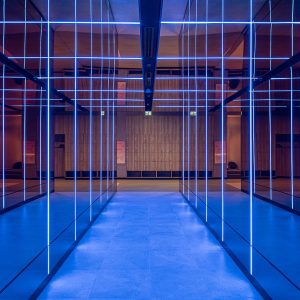
In 2017 innogy completed the reconstruction of its 20-year-old headquarters in Prague, Czech Republic, transforming around 10,000 sq m of closed offices into more collaborative spaces for 500 employees. The aim of the refurbishment was to significantly improve working conditions. A great deal of effort was put into achieving an environment focused on the wellbeing of the occupants, especially where the new lighting system was concerned.
During the engineering process, one of our partners in the reconstruction suggested lighting with changing chromatography, programmed to match the colour of the light outside with artificial lighting inside the offices.
We had two major criteria for the system installation. The first was to simulate daylight in the office throughout the whole day so that employees confined to the office building would feel more comfortable and energised, and also to give them a tool that would boost their energy levels when needed.
 The lifts are demarcated by a pastel blue in an otherwise all-white area
The lifts are demarcated by a pastel blue in an otherwise all-white area
One factor that influenced our decision was that the price difference compared to the good-quality standard lighting system originally planned was not that great – only one per cent of the total reconstruction costs. It was not difficult to advocate such a small cost increase.
The installation of the system was comparable to that of a standard lighting system. There are exterior sensor stations installed outside to match the daylight conditions with the interior lighting provided by 860 Philips PowerBalance tunable white ceiling fixtures and 96 Philips LuxSpace tunable white downlights. To optimise energy use, 150 PIR sensors detect human presence and switch the lights off in a room or area when it is vacated.
In the morning the lighting begins with a warm colour setting and evolves quickly to a blue colour spectrum delivering illuminance of 780 lux with a cool colour temperature of 5000K. Many employees complained that after lunch they felt more lethargic so we added a more intense cold-white colour just after lunchtime to help boost people’s energy levels. In the evening the lights gradually switch back to warm colours. The changes are purposely so slow that occupants are not aware of the shift in colour temperature. The system works automatically but there is an option to switch to a manual set-up and change the lighting scene for a selected number of work stations.
From my personal experience I have to say it works perfectly. However, it has shown us the weakness of the system. This lies not in the technology itself but in the behaviour of people. For the past 10 years we have been encouraging staff to turn off the lights as soon as the lighting conditions in the buildings are ‘acceptable’ to save electricity. Eventually people were turning the lights off even when the office was dark because they were used to doing the same thing at home.
Now we suggest that they keep the lights turned on throughout the whole day. We accept that we don’t save energy but we are happy to increase the energy levels of our employees. Then they can work more efficiently and go home earlier when they finish the job.
 A ring of colour is added to the reception desk in the entrance
A ring of colour is added to the reception desk in the entrance
There is one more difficulty to overcome when installing a lighting system in open spaces. Each of us has different sensitivities to light. Unifying the system for one part of the offices might be perceived negatively by those who are more sensitive to artificial light. But this can be resolved by programming each light fitting independently.
It was important to assess how successful the installation had been. A few months afterwards, together with Philips’ research department, we gave employees a questionnaire that focused on the lighting system but also covered other aspects of the office. Nearly 80 per cent of employees surveyed described the new lighting as better or much better than the previous fluorescent tube lighting, and 60 per cent agreed that it contributed to a place in which they wanted to work.
We also found out that it is extremely important that the installation of such a system is supported by training – explaining to employees how the human body reacts to light and how they can benefit from an artificial lighting system that changes colour temperature. The training is beneficial because it teaches them not only how to use the artificial light in the offices but also how to approach their lighting at home – using it to improve energy levels before work or school, and avoiding high-intensity and blue light before going to bed to aid quality of sleep.
After almost two years of experiencing the system I found that it had such a positive impact on my energy levels that I decided to install something similar at home. Waking up by light that continuously increases its intensity during breakfast energises the whole family and the level of morning stress has decreased dramatically.
Compared to other anti-stress activities I think that the system, especially compared to other wellbeing procedures, is extremely cheap. It is wise, however, to track the results of scientific research in this area. Fortunately the fittings can be reprogrammed to a different schedule if needed.





